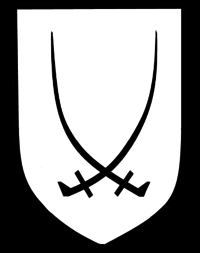56th Infantry Division (Wehrmacht)
| 56. Infanterie-Division German 56th Infantry Division | |
|---|---|
|
56. Infanterie Division Vehicle Insignia | |
| Active | 1939–45 |
| Country |
|
| Branch | Heer |
| Type | Division |
| Role | Infantry |
| Engagements | World War II |
The 56th Infantry Division (German: 56. Infanterie-Division) was a German military unit which fought during World War II. The division was formed in 1939 in Dresden, in the second wave of mobilisation (it was nicknamed Gekreuzte Säbel, 'crossed sabres', after the divisional symbol). After taking part in the Invasion of France in 1940, it spent the remainder of its existence on the Eastern Front, mostly with Army Group Centre. One of its early commanders was Paul von Hase, later executed for his role in the Widerstand, the German resistance movement.
Following heavy losses in 1943, the division was dissolved and its staff (along with remnants of Infantry Regiments 171 and 234) was incorporated into Korps-Abteilung D together with elements of the similarly depleted 262nd Infantry Division. This was itself largely destroyed to the west of Vitebsk when Third Panzer Army failed to hold the salient around the city during the Soviet offensive of June 1944, Operation Bagration.
Korps-Abteilung D was reformed, once more as the 56th Infantry Division, in East Prussia late in 1944. The Soviet East Prussian Offensive in January 1945 pushed Third Panzer Army west towards Königsberg, and the division was finally encircled and destroyed in the Heiligenbeil pocket, only around 250 men managing to break out westwards to Pomerania (the divisional staff, along with that of 18th Panzergrenadier Division, reformed as the staff of the Ulrich von Hutten Division, which participated in the Battle of Halbe).
Commanders
- Major-General Karl Kriebel (September 1939)
- Lieutenant-General Paul von Hase (July 1940)
- Lieutenant-General Karl von Oven (November 1940)
- Major-General Otto-Joachim Lüdecke (January 1943)
- Lieutenant-General Vincenz Müller (September 1943)
- Major-General Edmund Blaurock (September 1944)

